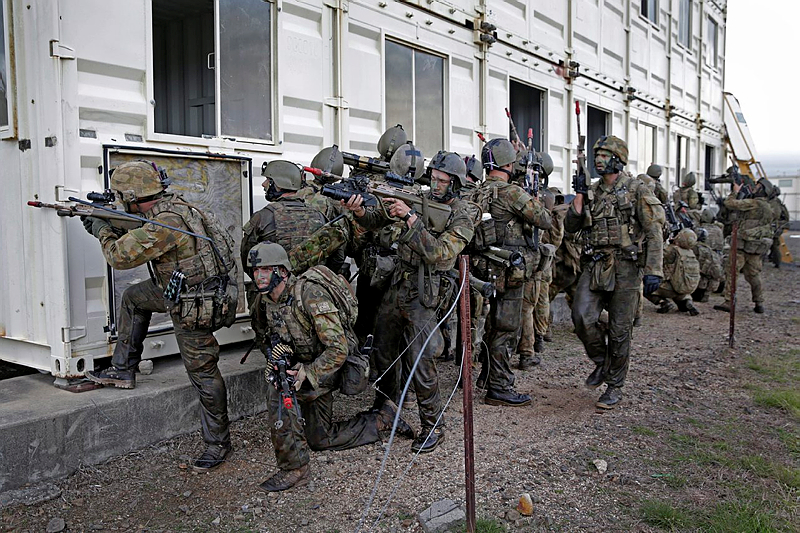Some recent contributors to The Strategist have championed the M4 over the EF88. Army is satisfied with the M4 for select Special Operations Command combatants. However, there’s no such a thing as the ‘perfect weapon’.
A recent article in the The Atlantic reported that the M4 as ‘the rifle that today’s infantry uses is little changed since the 1960s—and it is badly flawed.’ Every weapon has trade-offs—the M4 and EF88 included. Army has great confidence in the EF88 as the best general purpose weapon system available.
The new generation EF88 is substantially lighter that its predecessor. Ergonomically, it possesses a much better centre of gravity than the F88. By virtue of its cheek weld and ribbed butt-plate, it allows far better purchase when firing from the shoulder—with or without body armour and helmet.
Trials have indicated its revised trigger guard have made the weapon much easier to employ during both deliberate and combat shooting. The fluted barrel, revised gas plug and folding cocking handle have also enhanced the handling of the weapon.
The EF88’s grenade launcher is side opening and is one of the lightest available commercially. The extended rails on the top and side of the weapon allow several configuration options based on the mission and the operator’s preferences. As for length, the carbine version is shorter than the M4 by some 60 mm and the grenade launcher version is some 38 mm shorter than the M4A1 equipped with a grenade launcher.
Without revealing commercially sensitive information, extensive testing involving the firing of around half a million rounds has confirmed that the EF88 is a superior weapon in terms of reliability and maintainability—obvious essentials on the battlefield. Numerous trials have confirmed the EF88’s superior accuracy and lethality—two features which will be exponentially improved with the imminent roll out of new, state-of-the-art target acquisition equipment recently approved by Government.
The selection of the EF88 negates the requirement to requalify the ADF in a new weapon system. Instead, Army has been able to invest this training effort in enhancing its combat shooting capability with the EF88. The ADF’s supply, support arrangements and facilities will readily absorb the transition from F88 to EF88—as will its current and emerging vehicle, aviation and amphibious platforms.
Army has a long-standing collaborative relationship with Thales, which is offering a dynamic growth path to ‘future proof’ the rifle. Some of the features of this growth path include: a discrete attachment that will allow ambidextrous firing; a suppressor; reality based training ammunition, independent firing of the grenade launcher; and a central power unit.
Army identified a range of important considerations when selecting the ADF’s new assault rifle. The first of these was the need to avoid retraining the ADF in a new primary weapon system—unless the capability benefits offered by a new system clearly outweighed this cost. Avoiding such a penalty would allow Army to focus its weapon training on advanced marksmanship and combat shooting, as opposed to qualifying on a new system. Furthermore, it would negate having to retrain the ADF’s small arms maintainers in a new fleet.
Second, Army needed to ensure that its supply, support and storage of the new weapon system didn’t degrade its enduring readiness requirements—or those of the other services. Restocking the entire supply chain with new weapons, parts, specialist tooling, building new facilities and ranges, investing in new ammunition contracts, while disposing of legacy fleets, is a significant undertaking that could unhinge some of the ADF’s key readiness requirements.
Third, Army recognised that no capability acquisition occurs in isolation. Selecting a new weapon system could create numerous integration issues across existing/emerging vehicle, rotary/fixed wing and amphibious platforms. Indeed, an imprudent acquisition decision could produce myriad adverse capability ramifications for decades.
Finally Army sought a supplier who was commercially and technically reliable and who would collaborate with Army in ‘future-proofing’ the weapon throughout its life span. In Army’s experience, capability development is best served by cooperative and trusting relationships between capability manager and manufacturer. Finally, let’s not forget that successive governments have astutely designated small arms as one of our nation’s Priority Industry Capabilities.
The EF88 is the most robust and best general purpose assault rifle available. It delivers the ADF a lighter, more ergonomic, modular, reliable, accurate and lethal weapon.


